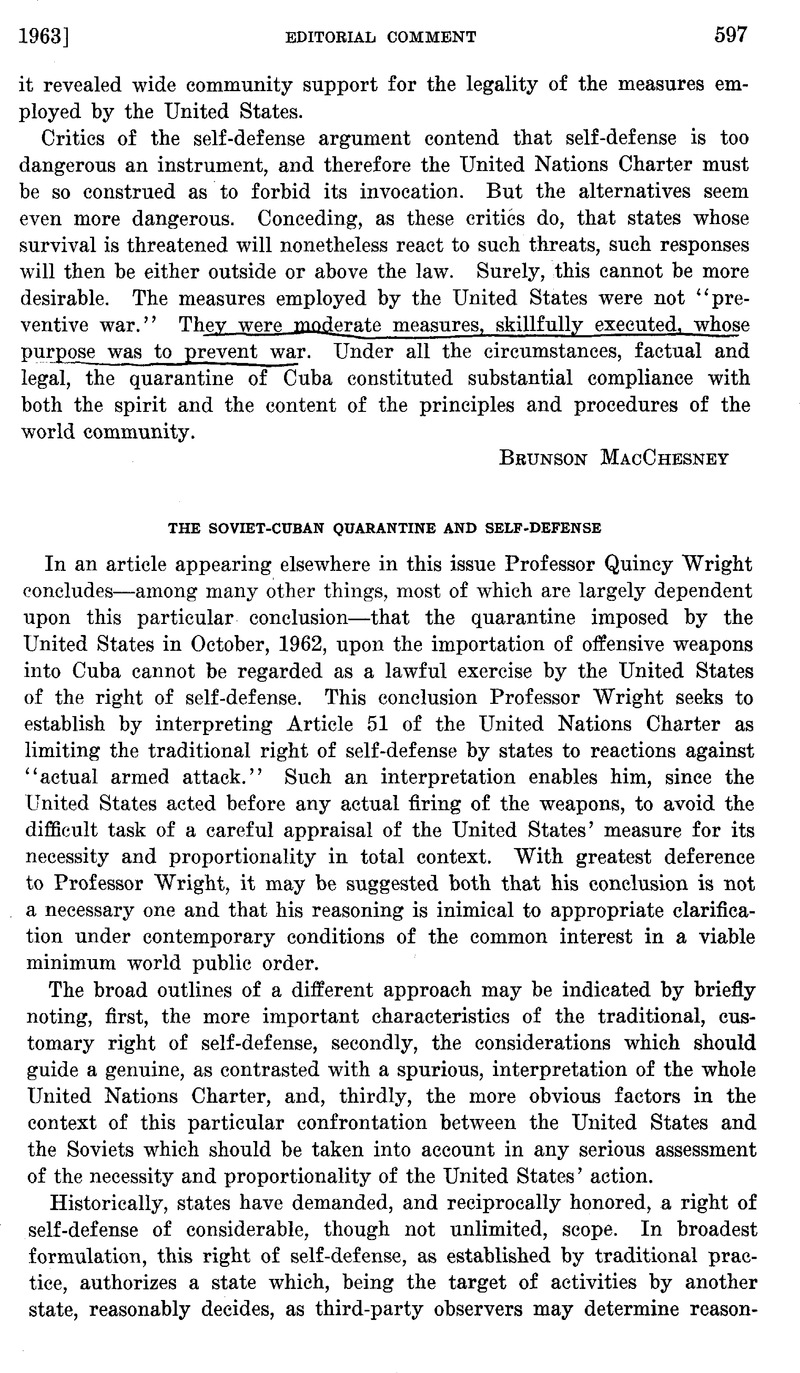Published online by Cambridge University Press: 28 March 2017

1 Fuller exposition and historical development of the principle are offered in Mc- Dougal and Felieiano, Law and Minimum World PublicOrder, Ch. 3 (1961). See also Bowett, Self-Defence in International Law (1958); Brownlie, “The Use of Force in Self-Defence,” 37 Brit. Yr. Bk. of Int. Law 183 (1961).
2 Brownlie, loc. cit. note 1 above, 202, 220, 227.
3 McDougal and Felieiano, op. cit. note 1 above, 229 et seq.
4 Mr. Webster to Mr. Fox, April 24, 1841, in 29 British and Foreign State Papers 1129, 1138 (1840-41). See also Jennings, “The Caroline and McLeod Cases,” 32 A.J.I.L. 82 (1938).
5 Brownlie, loc. cit. note 1 above, 209; McDougal and Feliciano, op. cit. note 1 above, 218.
6 The exact wording of Art. 51 may be noted:“Nothing in the present Charter shall impair the inherent right of individual or collective self-defense if an armed attack occurs against a Member of the United Nations, until the Security Council has taken the measures necessary to maintain international peace and security. Measures taken by Members in the exercise of this right of self-defense shall be immediately reported to the Security Council and shall not in any way affect the authority and responsibility of the Security Council under the present Charter to take at any time such action as it deems necessary in order to maintain or restore international peace and security.”
7 Bowett, op. cit. note 1 above, 188. Cf. Waldock, “The Eegulation of the Use of Force by Individual States in International Law,” 81 Hague Academy Eecueil des Cours 455, 497 (1952).
8 Eeport of Rapporteur of Committee 1 to Commission I, 6 U.N.C.I.O. Does. 446, 459. Discussed with further references in McDougal and Feliciano, op. cit. note 1 above, 235.
9 McDougal and Feliciano, op. cit. note 1 above, 237, note 261.
10 Relevant official utterances are collected in Mallison, “Limited Naval Blockade or Quarantine-Interdiction: National and Collective Defense Claims Valid Under International Law,” 31 George Washington Law Rev. 335 (1962), and in McDevitt, “The UN Charter and the Cuban Quarantine,” 17 The JAG Journal 71 (1963).
11 A comprehensive and persuasive review is offered in Mallison, loo. cit. note 10 above. The requirements of “collective self-defense,” not considered in this editorial, are also discussed by Mallison, as well as by McDevitt, loo. cit. note 10 above.
12 This point, among many others, is cogently developed by McDevitt, loo. cit. note 10 above.
13 The details of the action by the Organization of American States are presented in Mallison, and McPevitt, loc. cit. note 10 above.
14 The same conclusion is reached by Mallison,loo. cit. note 10 above, and McDevitt, loc. cit. note 10 above. See also Oliver, “International Law and the Quarantine of Cuba,” 57 A.J.I.L. 373 (1963); McWhinney, “ ‘Coexistence’, the Cuba Crisis, and Cold War International Law,” 18 International Journal 67 (1962-63); Seligman, “The Legality of the United States Quarantine Action in Cuba,” 49 A.B.A.J. 142 (1963); Larson, letter to the New York Times, Nov. 12, 1962, p. 28, cols. 5, 6;and statements by Professors Berle, Dillard, Lissitzyn, and Pugh in Columbia Law School News, Nov. 7, 1962. The approach in Chayes, “Law and the Quarantine of Cuba,” 41 Foreign Affairs 550 (1963), and, other official statements, builds more upon “regional arrangement” than upon self-defense. It is hardly to be expected, however, that general community expectation will immunize even the “political” or “ legislative” decisions of the Security Councilin reviewing regional measures from the basic constitutional policies of necessity and proportionality.
15 It may be remembered how the tone of professional and popular comment changed when Ambassador Stevenson introduced into the Security Council certain photographic exhibits of Soviet activities in Cuba. For a description of this occasion, see 9 U. N. Review 6, 11 (November, 1962).